Representatives of the European Space Agency (ESA) are proud to announce that the Johannes Kepler Automated Transfer Vehicle (ATV), the second spacecraft of the series, launched today, February 15.
The unmanned cargo ship is bound for the International Space Station (ISS), where it's due to arrive on February 23, after more than a week of chasing the space facility in low-Earth orbit (LEO).
After docking on the station, the capsule will remain attached to the ISS for about four months. During this time, the permanent, six-astronaut crew will unload all the cargo it contains, and then fill it up with thrash and other unnecessary materials.
The ATV is not reusable. This means that it will be deorbited above the Pacific Ocean, where it will burn up entirely, along with all the cargo it contains. In this regard, it is very similar to the Japanese-built H-II Transfer Vehicle (HTV) spacecraft series, and also with the Russian Progress capsules.
Johannes Kepler is the second ATV ESA constructs. The first one was called Jules Verne, and it successfully launched to the ISS on March 9, 2008. It was undocked in late September, and reentered Earth's atmosphere to meet a fiery death on September 29.
Now, about three years later, Johannes Kepler is getting ready to take to the skies as well. It is scheduled to take off tonight, at 22:13 GMT (23:13 CET), from ESA's launch facilities at the Kourou Spaceport, in French Guyana, South America.
The space capsule will reach the ISS just one day before the space shuttle Discovery is due to launch from the Kennedy Space Center (KSC), in Florida. The arrival of the orbiter will conclude a busy month, in which four space vehicles would have made their way to the station.
The Japanese HTV2 was the first, followed by the Russian-built Progress 41 space capsule. Johannes Kepler will be the third unmanned spacecraft to deliver tons of water, food, scientific experiments, propellant and personal items for the Expedition 26 crew in orbit.
“There is an incredible amount of hard work being done in these final weeks by teams from ESA, CNES, Arianespace and our partners. It’s gratifying to see such dedication to making Johannes Kepler ready for flight,” explains the ESA ATV program manager, Nico Dettmann.
“The operations teams from ESA, CNES and our industrial partners have worked very hard to make sure everything is ready, including many long hours of training to be ready in case of any contingencies,” adds ESA official Alberto Novelli.
“We are ready for ATV’s flight and everyone is keen to get to liftoff,” adds the expert, who is the ISS Operations Manager at the European organization.

 14 DAY TRIAL //
14 DAY TRIAL //